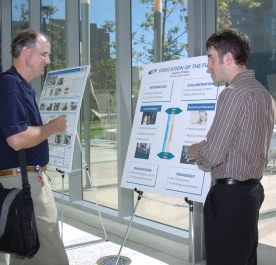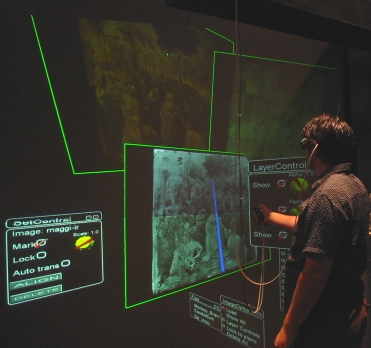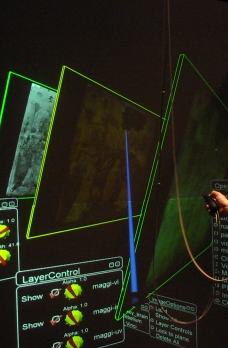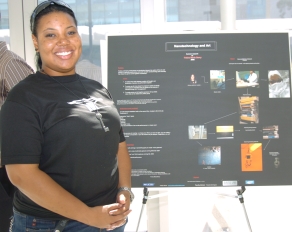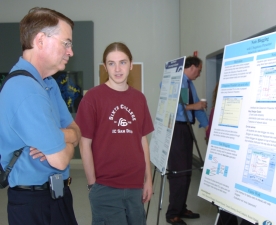Calit2 UCSD 2006 Summer Scholars Present Their Work
By Maureen C. Curran
|
San Diego, CA, September 27, 2006 -- The Calit2 UCSD 2006 Summer Undergraduate Research Program concluded last week with a reception and poster session. The 25 summer scholars just completed their 10 weeks as paid, full-time student researchers contributing to ongoing research activities in a wide range of fields, reflecting the multidisciplinary spirit of Calit2.
The students worked closely with a faculty advisor in their lab for the summer. For the first time in this six-year-old program, work took place in Atkinson Hall, the new home of the UCSD division of Calit2. Many of the projects were well anchored in the new facilities.
"Some projects would not have been possible, nor even conceivable, without the new facilities which Calit2 has brought forth," said Ramesh Rao, director of the UCSD division of Calit2. Rao is happy that "we are starting to see the beginning of the next generation of projects that take advantage of the facilities in an active way."
One such project was done by Philip Weber, working with Calit2 researchers Tom Defanti and Jurgen Schulze. Philip worked in the Calit2 "Cave" virtual environment on "Pattern Recognition in Multiple Visual Dataset Representations," using images from Mauricio Seracini's work on the "Adoration of the Magi" by Da Vinci.
|
||||
A number of other projects used the clean room wing on the first floor of Atkinson Hall. Computer engineering major, David Martin enjoyed the move into the new building and the availability of the class 100 clean room. "It is much cleaner than the old clean room," said David, "we are able to make things on a much smaller scale." His faculty advisors were Ivan Schuller, a professor of Physics and Andrew Kummel, a professor in the Chemistry and Biochemistry department. An interdisciplinary team if there ever was one.
|
Another project involving the clean rooms was Trisha Berry's examination of the intersection between art and nanoscience. "There are some very exciting young minds developing work in Calit2's Summer Scholars program, and I am happy that the performative matrix, of which performance art is central, is allowed to participate in the program." noted Ricardo Dominguez, an assistant professor in the Visual Arts department and Trisha's advisor. "Trish has been exemplary in trying to manifest the many kinds of gestures that explore the question of clean room science vs.. the 'dirty' science of art experimentation." A short video of this work will be available here soon.
Other facets of Calit2 UCSD are evident as well. Bioengineering major Jameson (Jamie) Rogers had previous research experience with the Scripps Institute of Oceanography, so he was "a perfect fit to the goals and technology of CAMERA and its central role in Calit2," according to his faculty advisor, vice chancellor of research John Wooley. CAMERA is Calit2's Cyberinfrastructure for Advanced Marine Microbial Ecology Research and Analysis project. Wooley is also an adjunct professor in the UCSD School of Medicine's Pharmacology department. Rogers will stay on with CAMERA until he graduates.
Philip Weber who did the visualization project discussed previously will continue working with Calit2's Schulze and will also be part of CAMERA. Schulze enjoyed his first experience as a Summer Scholar advisor. He hosted one of the weekly power point sessions where students learn all the facets of presenting their research. He was particularly pleased to see the motivation and enthusiasm of the students. He was also happy with the results of Philip's project: "Philip hit the ground running and made a lot of progress. This was valuable research, and we will be writing a paper."
In fact, the next step for many of this year's summer scholars is to continue their work, remaining with their research group through the next phase of their project.
|
William Griswold and Beth Simon of the Computer Science and Engineering department advised David Lindquist and Michael Kelly. Each student created an extension for Ubiquitous Presenter (UP), which is an outgrowth of the University of Washington's Classroom Presenter. These are software tools which extend and enhance the classroom experience and create an active learning environment. They are specially designed for use in large classes of 100+ students.
Michael designed and implemented an application that enables "note blogging" within UP: the ability for a student with a tablet PC to mark up the instructor's presentation slides in real time, which can be viewed by other students (as well as the professor) during the class, or later via the Web. Griswold noted that "this system will be deployed for use in a class this fall as part of our continuing research." David designed a plug-in for UP, whereby submissions can be made in real time to the instructor via existing cell phone technology, using either text messaging or photo messaging. He coauthored and submitted a paper to ACM SIGCSE 2007 (Annual ACM Computer Science Education conference) on this summer's work.
For past, and present, undergraduate scholars the opportunity to pursue research full time, without interruption from class work, can be a powerful experience which guides their career choices. "My project on 'Globalization and Changes in Education' gave me the chance to break into the field of educational research," said Steven Phillips. His faculty advisor Olga Vásquez, an associate professor in Communication elaborated: "I believe that the Calit2 Summer Scholars experience was singular in Stephen's academic career. The change in his commitment, knowledge and performance was transformative."
|
Electrical engineering major Jacob Sendowski found that as a result of the program, he now realizes "what it really takes to be a researcher." He worked with Shaya Fainman, a professor in the Jacob's School of Engineering's ECE department on "Surface Plasmon Resonance Sensor." He has plans to continue the work as a design honors thesis this coming academic year.
The event was well attended. In addition to showcasing the research accomplishments of this year's summer scholars, it was the first of future informal events which will provide a venue for the members of Atkinson Hall's diverse community to come together.
First-floor denizen Todd Margolis dropped by and found "lots of good stuff." He explained: "This is surprisingly advanced research, beyond what I would expect from undergraduates. There are very specific, well-defined research goals and many of the students seem to have found interesting solutions." Margolis is the technical director of the Center for Research in Computing and the Arts (CRCA).
Related Links
PDFs of the students' posters will be available shortly; link will be here when they are posted.
Related Articles
Convenience Store as Laboratory
UCSD Summer Undergraduate Research Scholars Announced
Calit2 UCSD Summer Undergraduate Research Scholarships
Calit2 Summer Undergrad Research Scholarships


